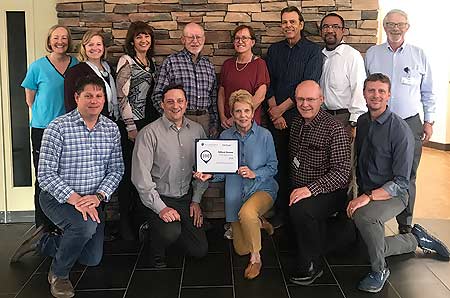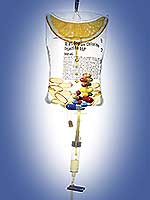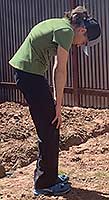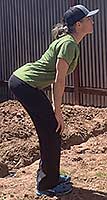|
|
HEALTHY HAPPENING May 2019
|
Top Four Negative Effects of Sugar in Your Diet
|
As a physical therapist I often get asked about diet or my opinion on some diet fads. What I listed below is the truth, not fad, but the harsh truth about sugar. Sugar is often hidden in many foods and the best place to look is on the label. Check how many grams of ‘added sugars’ each product lists. So why should you care? I listed the top four reasons below, and listed two bestselling books to help guide you toward a sugar-free diet and a reduction in sugar cravings.
1.Causes Cravings and Addiction
Sugar addiction is a real and growing concern for a large majority of the world’s population. But how does this happen? The Huffington Post (4/6/2015 article) explains that when a person consumes sugar, the tongue’s taste buds become activated and signals the brain, “lighting up reward pathways and causing a surge of feel-good hormones, like dopamine, to be released.” Stimulating these reward pathways with sugary treats is okay from time to time, but over-activating them can lead to more serious concerns such as “loss of control, craving, and increased tolerance to sugar.”
2. Impairs Memory and Learning Skills
People who consume too much fructose—otherwise known as added sugar—produce less of the chemical brain-derived neurotrophic factor (BDNF). As BDNF assists the brain with learning and the formation of new memories, without a sufficient amount of it the source says “we can’t learn (or remember) much of anything.”
Additionally, research out of UCLA found that a high-fructose diet actually slows the brain down. The study found that rats who consumed too much fructose “had damaged synaptic activity in the brain, meaning communication among brain cells was impaired.”
3. Contributes to Depression
Consuming too much added sugar can also have major impacts on your mood and mental health. One example of this is what’s commonly referred to as a ‘sugar crash,’ where the body’s blood sugar spikes upon consumption of a sugar-rich snack or beverage, and then plummets soon after, leaving you “feeling anxious, moody or depressed,” says The Huffington Post. The source adds that, besides a sugar crash, over-consumption of fructose can “mess with the neurotransmitters that help keep our moods stable.” One such neurotransmitter is serotonin, which boosts our mood after eating sugar. Unfortunately, the body only has a limited amount to offer, and the more frequently it’s released the faster the body’s supply is depleted, leading to symptoms of depression.
4. Inhibits ‘Overeating’ Sensor
It’s common knowledge that over-consumption of sugar can lead to weight gain, and in severe cases obesity, but researchers are now coming to understand exactly why. They have recently discovered that “chronic consumption numbs the brain’s anorexigenic oxytocin system, the sensor that prevents overeating.” With this crucial sensor disabled—on an almost-permanent basis in some individuals—“our brain doesn’t release hormones to signal that we’re full,” resulting in excessive overeating, thus perpetuating the problem even further.
If you have any questions, please call Moab Physical Therapy and Rehabilitation located downtown at 83E Center Street. (435) 210-1985. Follow us on Facebook or Instagram @MoabPT.
|
Moab Regional Hospital recognized as a 2019 Top 100 Critical Access Hospital
|
The Chartis Center for Rural Health announced it’s Top 100 Critical Access Hospitals for 2019. Moab Regional Hospital has received this award based on 2018 performance and numbers.
Critical Access Hospital is a designation given to eligible rural hospitals by the Centers for Medicare and Medicaid Services (CMS). Hospitals must provide 24-hour emergency care and be located at least 35 miles from another hospital among other conditions for eligibility. The CAH designation is designed to reduce the financial vulnerability of rural hospitals and improve access to healthcare by keeping essential services in rural communities.
 |
Front Row Left to Right: Jonas Munger, MD, Sam Crane, Sue Kirkham,
Robert Farnsworth, Board Chair, Dylan Cole, MD, Chief Medical Officer
Back Row Left to Right: Dee Gulledge, Jen Sadoff, Chief Executive Officer, Beth Logan, Bob Jones, Kim Brandau, MD, Doug Fix, Vice Chair, Ronnie Boongaling, Director of Physician Services, Rick White, Interim Chief Financial Officer
Missing: David Everitt, Vicki Gigliotti, Chief Clinical Officer |
“In an era of increased complexity and uncertainty, Top 100 hospitals have established themselves as a bellwether for rural provider performance,” said Michael Topchik, National Leader of The Chartis Center for Rural Health. “Top 100 status is a real indicator of how proactive these hospitals are when it comes to pushing for performance improvement in areas such as quality, outcomes, patient safety, market share and finance.”
“Moab Regional Hospital is dedicated to ensuring the community has access to high quality healthcare. We are committed to keeping our costs affordable and have taken steps to maintain financial stability for our community and those we serve” said Jen Sadoff, Chief Executive Officer. “There are 1,349 Critical Access Hospitals located throughout the United States and we are honored to be recognized in the top 7%. (Moab Regional Hospital last made the Top 100 list in 2016.)
“The Administration and physicians at Moab Regional Hospital are very supportive of high quality care and patient satisfaction” shared Darci Miller, Director of Clinical Support Services. “We participate in many reputable education and training programs that are optional for a facility of our size.”
The independent scoring organization, iVantage Health Analytics uses 50 publically-available and rural-relevant indicators across eight pillars of hospital strength to create the Hospital Strength INDEX. They include: patient outcomes, patient perspective, quality and financial stability.
To read more about the Top 100 ranking visit www.ivantageindex.com/top-performing-hospitals
|
Ready To Boost Your Performance
To A New Level?*
|
Most people think IV (Intravenous) therapy is only used in hospitals or in emergencies. IV therapy is also extremely effective in delivering nutrition to our bodies. It’s a natural way to get total absorption of the vitamins, minerals, and amino acids your body needs. When you take pills by mouth, your body only absorbs a small fraction of the nutrients. Worse, some common medications actually strip essential nutrients from your body. 
At Prestige Wellness Institute in Utah County and Moab, Utah, patients receive IV therapy to help with all kinds of needs, including improving athletic performance, speeding recovery from workouts, accelerating healing from surgery, rehydration, and detoxifying heavy metals. We also use IV nutrition to help patients with chronic fatigue, colds, flu, depression, Parkinson’s, migraines, asthma, muscle spasms, cancer, heart disease, and more.
For athletes, IV therapy provides both hydration and vitamin supplementation. Why vitamins? Because every muscle—especially the heart—requires enormous amounts of energy. This is made in little powerhouses called mitochondria, which require lots of vitamin C, B vitamins, and magnesium. For this reason, we load you up with all of these essential nutrients in a form that is 100% absorbable by the body.
 Whether you are getting ready for a big event or recovering from one, pump yourself up with our IV drip cocktail. It’s the one cocktail that doesn’t leave you with a hangover! Runners, cyclists, and other athletes in Los Angeles, New York City, Las Vegas, and other large cities take advantage of IV therapy. Now, you can do the same, at a fraction of the cost.
Call (435)259-4008 for your IV today. For more information, visit our website at www.prestigewellnessinstitute.com.
* These statements have not been evaluated by the Food and Drug Administration. These products are not intended to diagnose, treat, cure or prevent any disease. This material is provided for informational purposes only and is not medical advice. Always consult your physician before beginning any treatment or therapy program.
|
| 3 Exercises for Pain Free Gardening |
 Spring is here! Time to prepare the soil for your garden, which can mean spending several hours bent over with your hands in the dirt, pulling weeds and planting. Although weeding and gardening can be greatly rewarding tasks, leading to delicious home-grown food and beautiful flowers, the work and postures involved can leave you achy and stiff. Break up your outdoor work sessions with the following exercises: Spring is here! Time to prepare the soil for your garden, which can mean spending several hours bent over with your hands in the dirt, pulling weeds and planting. Although weeding and gardening can be greatly rewarding tasks, leading to delicious home-grown food and beautiful flowers, the work and postures involved can leave you achy and stiff. Break up your outdoor work sessions with the following exercises:
1. Standing Cats & Dogs
Often, after being hunched over for a while, it can be hard to straighten back up. The back muscles feel tight and stuck in place. This first exercise brings movement and blood flow to these overworked tissues. It is like giving yourself a massage, taking the spine through a full range of motion.
Stand with your feet hip width apart and pointed straight ahead with a slight bend in your knees.
The Cat
Starting at the pelvis, tuck your tail under and allow your head to drop forward. This movement lengthens your spine from your tailbone to your head. Create space in your upper back by moving your shoulder blades out and away from your spine. 
The Dog
Reverse this movement, again starting at the pelvis. Roll the front of your pelvis forward so it moves closer to your thighs, forming an arch in your lower back. Bring your shoulder blades down and together to extend the upper back and open your chest. Lift your head and arch your neck to look up at the sky.
Exhale as you move into the Cat, and inhale as you go into the Dog. Hold each position for 3 seconds and repeat 10 times.
2. Sitting Assisted Hip Lift
The hips can become tight because of the constant deep hip flexion used when crouching down to work in the garden. The follow exercise opens the muscles in the front and back of the hip joint.
Sit on a chair, step, bucket, or whatever is easily available, at a ninety degree angle between your hips, knees and ankles. Place your feet hip-width apart and pointed straight ahead. Be mindful that as the seat lowers, the stretch will be more intense.  Roll your pelvis forward until your sit bones--the bones on the bottom of your pelvis--are both pointing straight down and are equally weighted. Your lower back should be slightly arched, and your shoulders should be aligned with the hips. This position should feel comfortable without muscular strain. Roll your pelvis forward until your sit bones--the bones on the bottom of your pelvis--are both pointing straight down and are equally weighted. Your lower back should be slightly arched, and your shoulders should be aligned with the hips. This position should feel comfortable without muscular strain.
Cross your opposite ankle over your knee. Reposition the pelvis as needed to regain balance in the sit bones. Using the muscles around your hips (not your hand), press your knee down toward the ground. (To reposition the body, you need to train and strengthen your body in correct posture: hence, no hands. If you simply push your knee down with your hand, you take the body through a passive range of motion without the benefit of strengthening the tissue and repositioning the bones for lasting postural changes.)
Lengthen through your spine, and gently pinch your shoulder blades down and together. Hold this position for a minimum of one minute. Practice deep diaphragmatic breathing into all aspects of your torso—front, back and both sides. Repeat on the other side.
3. Standing Overhead Extension
This exercise lengthens the body from head to toe.
Stand with your feet hip width apart and pointed straight ahead with your knees straight, but not locked out.
Interlace your fingers and slowly bring them above your head. Tilt your head back to follow your hands with your eyes. Be careful to maintain good alignment with your rib cage and pelvis. You will feel your abdominals engage to hold the correct position. Note: It is common for the chest to lift, pelvis to roll forward, and lower back to overly arch as the arms raise above the head, but be sure this doesn’t occur. When this happens, you are no longer receiving the benefit of repositioning the upper back and shoulders. Rather, the lumbar spine is compensating to bring the hands farther back.
Keep your elbows straight and close to your ears. While deeply breathing, hold this position for a minimum of one minute.
Following my time in the garden, I relieve the tension in my body by resting in the Static Back or 90-90 Position, which was discussed in a previous article and can be found on my blog: The Best Position to Relieve Back Pain https://thepfathlete.com/the-best-position-to-relieve-back-pain
Wishing you a green thumb and bountiful crops!
Jessica Kisiel, MS, is a local wellness professional specializing in injury recovery and pain management through alignment. She is certified by the Postural Restoration Institute® and Egoscue University®. Enjoy more articles like this by joining The Pain Free Athlete community, www.thepfathlete.com |
| |
|
|
|
|
|
|
© 2002-2024 Moab Happenings. All rights
reserved.
Reproduction of information contained in this site is
expressly prohibited.
|
|